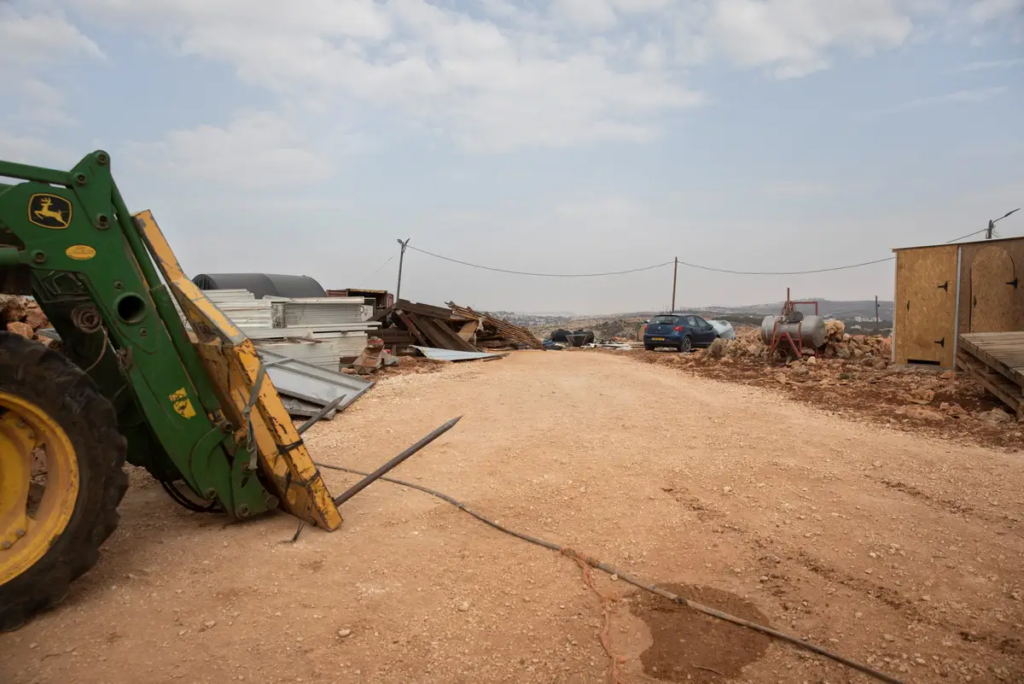Israel’s Housing Ministry ‘took advantage of a plan approved 30 years ago to dramatically change the heart of the West Bank,’ says Hagit Ofran of activist group Peace Now
A new neighborhood in Ariel planned to be built some 2 kilometers (1.2 miles) away from the settlement’s main residential area would impede the future expansion of the neighboring Palestinian town, Salfit.
West Ariel is planned as a new neighborhood noncontiguous to the rest of the West Bank city. The parcel set aside for the neighborhood, whose first phase of construction includes 730 residential units, is within Ariel’s jurisdiction but adjacent to Salfit.
In October, about 30 years after the plan for West Ariel was approved, the Construction and Housing Ministry published a request for proposals, inviting developers to submit price quotes for its construction. The hill chosen for the new neighborhood,currently occupied by the unauthorized outpost of Nof Avi, was previously the site of demonstrations by Salfit residents.
“This neighborhood is like a completely new settlement,” the governor of Salfit Governate, Abdallah Kamil, told Haaretz. The Palestinian Authority has asked Israel to suspend the plan, he said.

“Salfit is slated for expansion. It has a university and there are plans to add 10,000 students over the next few years. The city’s master plan will have to be enlarged, and the site where the new settlement is planned is exactly the direction toward which we wanted to expand,” Kamil said. “This situation will explode. We also told the Israelis this; it will open a new front and it will harm Israeli security. It’s clear that part of the plan’s purpose is to eliminate any chance of a political solution.”
Ariel has about 20,000 residents and a jurisdiction of about 3,460 acres. In comparison, the northern Israeli city of Nazareth has a comparable area but a population of 77,000. The city of Salfit had 10,800 residents as of 2017. The Salfit Governate, which also includes the surrounding villages, had a total population of about 70,000.
Ariel’s area of jurisdiction is not contiguous, mainly due to parcels of Palestinian-owned land in the area. Thus, the city’s municipal area contains many enclaves of private Palestinian land that could be used for Salfit’s expansion.
The 730 residential units planned for West Ariel in the first phase are part of the plan that Construction and Housing Minister Zeev Elkin announced last month to build about 1,300 new homes in settlements. His ministry is responsible for planning and building in larger settlements, like Ariel. A senior official told Haaretz that while the approvals by the Supreme Council captured the world’s attention, “the truly dramatic matter is the 1,300 units that were sent out to bid.” The official, who spoke with Haaretz on the condition of anonymity, said the plan grew out of conversations that settlers held with Elkin and the cabinet. An additional plan for West Ariel, on land owned by a private developer, was approved in the 1990s. If it goes ahead, an additional 800 residential units could be built.
“Ariel’s jurisdiction begins at [Ariel] University and ends at the industrial zone [located west of the proposed neighborhood and also noncontiguous with the city’s built-up areas]. We’re planning additional neighborhoods there in the future. So what if it’s near Salfit,” said Ariel Mayor Eli Shviro.

West Ariel could end the housing shortage in his city, he said.
“There were periods when almost [no new construction] was approved and the city grew older” because people who were born there were forced to leave due to the housing crunch, said Shviro. “The time has come to approve this neighborhood, which has been planned for a long time.”
West Ariel will be built on state land that is within Ariel’s jurisdiction and will not encroach on privately owned land, he said. “We are within the consensus, and I praise Elkin and Prime Minister Naftali Bennett for approving the new neighborhood,” Shviro said, adding: “Ariel has Ariel’s land and Salfit has Salfit’s land. I don’t take from them and they don’t take from me.”
Hagit Ofran of Peace Now said the plan would not have been approved had it been submitted to the cabinet for a vote or been discussed in a public forum.
“The Housing Ministry took advantage of a plan approved 30 years ago to dramatically change the heart of the West Bank,” she said. Peace Now officials, echoing the governor of Salfit Governate, call the proposed neighborhood a new settlement and said it would wreak great damage to life in the area and the likelihood of reaching a two-state solution.
About a year ago the unauthorized settlement farm outpost of Nof Avi was established on part of the site designated for West Ariel. These ranch outposts are becoming increasingly common, since they enable a small number of residents to take control of large areas by grazing livestock. Sara and Israel Rapoport live in Nof Avi, which includes a sheep pen and two homes. When we visited them this week, there were also two Thai workers there.
The Rapoports came to Nof Avi after they were evicted from a similar outpost they established near the settlement of Kedar. They say they are there to guard the state-owned land, preventing Palestinians from squatting on it until the new neighborhood is built, before moving on.
Shviro, Ariel’s mayor, told Haaretz he wasn’t familiar with the outpost.
When Nof Avi was established, Palestinians demonstrated against it, saying it caused them to lose access to their own agricultural lands.
Another issue for residents of Salfit is the access road to West Ariel. The main entrance to Salfit is just meters before a checkpoint at the entrance to Ariel. The road, while designated a “main thoroughfare,” is in fact a narrow, winding road between the Palestinian town and Route 5, a highway. The road to the new neighborhood branches off of this road, leading Salfit residents to fear that at some point they will be prohibited from using the road due to “security concerns.”
Shviro says the fears are unsubstantiated and there are no plans to restrict Palestinian traffic on the road.
Construction and Housing Ministry sources said the multi-year delay in launching West Ariel stems from difficulties in planning the neighborhood’s access road. Only now, after these problems were solved, could the tender process begin to build the neighborhood, said ministry sources. The original plan for the road would have encroached on private land, said the sources. In 2015, after the route was altered, planning of the road began in earnest.




